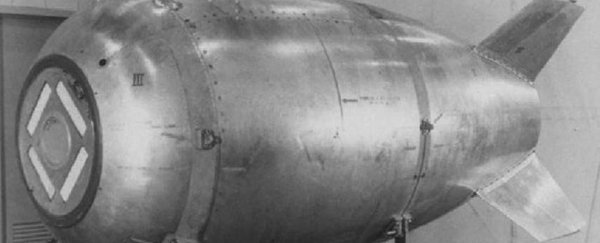The remnants of the first nuclear device to ever go missing may now have been found, after a diver discovered an unusual object lying on the ocean floor off the west coast of Canada.
The so-called 'Lost Nuke' dummy bomb had to be jettisoned from a US B–36 bomber during a simulation exercise in 1950, after icy buildup in the plane's systems saw the engines fail. The plane wreckage was discovered in British Columbia in 1953, but the bomb itself has never been found.
Until now – possibly – thanks to commercial diver Sean Smyrichinsky, who was looking for sea cucumbers last month off Pitt Island, near Haida Gwaii.
"I got a little far from my boat and I found something that I'd never ever seen before," he told CBC News. "It resembled, like, a bagel cut in half, and then around the bagel these bowls moulded into it."
While Smyrichinsky wasn't sure what to make of the discovery, he was convinced he'd found something special.
"I came out from the dive and I came up and I started telling my crew, 'My god, I found a UFO. I found the strangest thing I'd ever seen!'" he told CBC News.
When the diver told some local fisherman about the object, a more probable explanation surfaced.
"Nobody had ever seen it before or heard of it, (because) nobody ever dives there," Smyrichinsky told John Mackie at the Vancouver Sun. "Then some old-timer said, 'Oh, you might have found that bomb'."
The bomb in question belonged to US Air Force flight 44–92075, which originally was meant to simulate a bombing run over California on 13 February 1950 before landing in Texas.
For the purposes of the simulation, the 'dummy' Mark 4 nuclear bomb was not actually loaded with plutonium, but contained a mixture of lead, natural (not enriched) uranium, and TNT. As such, it was capable of a conventional TNT-based explosion, but not a nuclear detonation.
That payload could still have posed a huge risk to anybody on the ground if the bomb were to impact with the surface, so once the B–36's crew ran into engine trouble after taking off from Alaska, they jettisoned the dummy weapon off the coast of British Columbia and detonated it in mid-air.
The crew then abandoned the plane after setting it on autopilot, with the bomber eventually crashing onto the side of BC's Mount Kologet, about 300 kilometres (186 miles) away from where the bomb was jettisoned.
Five of the crew died, but 12 others were eventually rescued after parachuting onto Princess Royal Island.
There's no official confirmation yet that what Smyrichinsky found is a remnant of this famous bomb, but after he researched the B–36 story and found images of the Mark 4 online, he's convinced they're a match.
"The picture I found has the bomb in sections, they've got it taken apart," Smyrichinsky told the Vancouver Sun. "And in the middle, there's a great big thing that looks just like what I found."
"The Mark IV bomb uses these things called pit balls," he added. "These pit balls have the explosives in them, and they're quite large, bigger than basketballs. So what I think I found was the housing that holds these pit balls."
Once Smyrichinsky made up his mind that the object could be the lost nuke, he informed the Canadian Department of National Defence, which told him the discovery had their "collective attention", and that they'd be "looking into this matter with keen interest".
A Royal Canadian Navy ship has been dispatched to investigate, and is expected to know more in a few weeks. Until then, we won't know if the lost nuke has finally been discovered, but it looks like there's a good chance.
According to Major Steve Neta of the Canadian Armed Forces, the site of Smyrichinsky's discovery matches up with the bomber's flight path – and while everybody's still being cautious, it could mean that this nuclear mystery may finally about to be solved.
"[W]e do want to be sure and we do want to investigate it further," he told CBC News.
